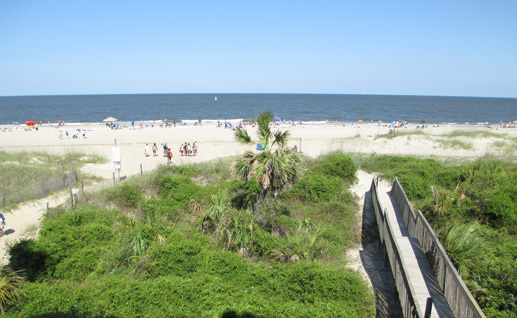Severe beach erosion can be a significant problem for coastal communities affected by hurricanes and tropical storms like Hurricane Sandy. To assist Georgia communities in future recovery efforts, the University of Georgia Skidaway Institute of Oceanography entered into a cooperative agreement with the Bureau of Ocean Energy Management to evaluate existing data on Georgia’s offshore sand resources and identify where more data are needed. This consolidated information will increase knowledge of Georgia’s offshore sand resources and contribute to long-term coastal resilience planning.
“Georgia’s sand resources are arguably the least well-known of those along the East Coast, and this project will provide critical data and insights to enhance coastal resilience,” said UGA Skidaway Institute professor Clark Alexander. “The work is being coordinated closely with the Georgia Department of Natural Resources and the state geologist to assure that our findings are disseminated rapidly and broadly.”
Under the $200,000 agreement, UGA Skidaway Institute will gather, evaluate and analyze existing geological, geophysical and benthic habitat data off Georgia’s coast and identify gaps in the information. Based on the data gaps, project scientists will suggest areas for future geologic studies to confirm previously identified sand resources and locate new ones.
“A reliable inventory of offshore sand resources will help the Department of Natural Resources be effective at representing the state’s interest in discussions with BOEM and other federal agencies. We appreciate the initiative of Dr. Alexander and the UGA Skidaway Institute and look forward to the results of this project,” explained Spud Woodward, director of the Georgia DNR Coastal Resources Division.
The current project will be limited in scope – primarily evaluating and consolidating existing data regarding Georgia’s offshore resources.
“Since the 1960s, there have been quite a number of small studies, but the information is scattered,” Alexander said. “This project contributes significantly toward the goal of more fully understanding available sand resources by synthesizing existing information into a single, digital resource.”
Much of the older information is only available in printed form, and needs to be converted to a digital format to be useful in the software that managers and scientists use for viewing and analyzing data. The goal of the project is to have all the compiled information readily accessible to coastal managers and municipal planners.
“This agreement demonstrates BOEM’s commitment to work with Georgia to help coastal communities recover from the effects of Hurricane Sandy and enhance resilience efforts for the future,” said BOEM Acting Director Walter Cruickshank. “We are committed to continuing to work in a collaborative manner to help local communities withstand damage from future storms.”
This agreement is one in a series of partnerships with 14 coastal Atlantic states, using part of the $13.6 million allocated to BOEM through the Disaster Relief Appropriations Act of 2013. The combined agreements support research that will help to identify sand and gravel resources appropriate for coastal protection and restoration along the entire Atlantic Outer Continental Shelf.



